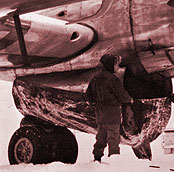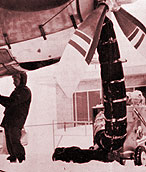 |
 |

At the main maintenance bases of MSP, MDW/ORD and YIP/DTW, where our maintenance personnel were stationed, the aircraft were pre-flighted, including engine run-up, by the mechanics. During the night, the a/c that overnighted at these bases were subjected to maintenance procedures ranging from light to heavy checks. The part that our maintenance department played in keeping our aircraft at a high level of reliability which lead the industry, can not be overemphasized. At ORD I knew many of these mechanics on a first name basis. On many occasions, one of the foremen that I knew quite well, Stanley Statchura, would come to me and ask me to monitor a particular system that they had worked on but could not really duplicate until the aircraft was airborne. I was always glad to help with something like that because it enabled me to know more about the particular a/c that I was flying. Knowing all I could about the various aircraft systems was something I took a real interest in. In the case of a short range turn around, say from ORD to GRB and return, he would send along a mechanic with us to check a system in-flight. That was the dedication of the maintenance department at NCA.
And not to be forgotten were our stewardesses and the part they played in seeing to the comfort of our passengers, whether in the heat of summer or the deep cold of winter. Standing in the open doorway of the DC-3 and Convair aircraft to wish the departing passengers a “good day” or greeting the boarding passengers, these ladies played a very important part not only to the area of safety but also the overall comfort of our many passengers. Many is the time that I knew that our 100+ passengers on the DC-9 would at least receive a beverage on a thirty minute flight from MSN to ORD.
The six minute stop at the ramp, on through flights, kept us on schedule. On the DC-3 and CV-440, if all cargo/baggage could be handled by using “interior” access to the cargo bins by the station agents, the right engine would be left running with the passengers deplaning/emplaning all in a matter of a few minutes. Having the a/c on the ground a very short time also added to the fact that very little, if any, snow would accumulate on the wings at a stop, thus eliminating the need for snow removal from the aircraft.
On origination of the flight, the flight crew would accomplish a complete engine run-up and then at subsequent enroute stations, during warm, non-winter temperatures, the flight crew was authorized by the FAA to accomplish a “rolling” mag check. This procedure took place at some point during taxi to the active runway. The captain would slow the a/c almost to a stop; on the straight away or coming out of a turn, he would then “drag” the brakes a bit while at the same time advancing the throttles to a predetermined RPM point and the F/O would run both mag switches through the left-both and right-both positions. Our line operation was one of keeping the a/c moving and that translated into an industry leading “on time” performance. In colder weather, the crew would stop short of the runway and accomplish a normal run-up first by “running” the props through at least one cycle to assure that warm engine oil was pumped into the prop dome, followed by a mag check.
There was a high degree of “hustle” present in our operation, from the operation of the a/c to the ramp chores being accomplished in a “no wasted motion” atmosphere. Time was money and money was not to be squandered.
At the time that I went to work at NCA, in April 1959, it was common place for the flight crews to fly between ten and twelve legs during a sixteen hour duty day. As an example, from Chicago the early morning originating flights departed between 6:45 and 8:00 AM heading north and east out of the “windy city.” A north bound flight might be flight 573 departing at 7:00 AM with stops at MKE, MSN, STE, AUW, RHI, IWD and terminating at DLH around noon. Time out for a quick lunch in the terminal restaurant and then on to MSP. Leaving MSP on flight 468 about 4:00 PM with stops at ONA, LSE, MSN, JVL and finally back to Chicago arriving about 8:00 PM. In the winter, that “day” could be a long, IFR day, with perhaps two thirds of the arrivals coming from instrument approaches. Our flight crews were quite proficient at the art of making ADF and VOR approaches. The ILS approaches at the termination points of MSP, YIP/DTW and MDW/ORD were a “piece of cake” so to speak. Our crew on that particular trip would fly that sequence of flights ten days out of the month, usually M-W-F one week, then Tue & Thu the next week, racking up 80:00 to 85:00 flight hours and up to 130 takeoffs and landings during the month. Similar trips existed at the Detroit and Minneapolis crew bases, too.
As the aircraft equipment became more complex, in the late 1960s and early 1970s, the operation slowed down measurably. Our six minute stops at through stations turned into at least fifteen minutes. But this was also brought about by the fact that our a/c passenger capacity increased from 26 on the DC-3s to 100+ on the DC-9s not to mention the increase in cargo volume. Our average stage length also increased many fold....ah yes, progress was here. With the increase in stage length came a corresponding decrease in the number of legs that the crews flew per duty period and no one complained about that.
At times I have sat back and reflected how our company moved forward in those times of simplicity and the many achievements that the company was able to accomplish as NCA brought air transportation to many small communities across the upper mid-west where rail and bus transportation had long ago vanished. Even today, in the 21 century, there is still airline transportation available at a vast majority of these same stations and it began, in many cases, with North Central Airlines. “Americas leading local service airline”.
copyright 2007 - Captain Richard A. Brown
